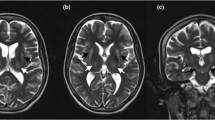Abstract
Wilson’s disease (WD) was defined in 1912 as a rare autosomal recessive disorder that leads to defective excretion of copper from the body. Normally, copper is absorbed in the small intestine by enterocytes and transported into the blood via ATP7A proteins. Any excess copper is directed to the liver and excreted by hepatocytes via ATP7B. However, in patients with WD, this ATP7B protein is mutated, and copper accumulates within the body, causing various symptoms. Wilson’s disease can manifest in many different ways, such as neurological, fulminant hepatic fibrosis, ophthalmic, and even psychiatric presentation types, making it difficult to diagnose. Wilson’s disease is essential in the differential diagnosis of an individual expressing neurological symptoms because it is a treatable disease that can progressively increase in severity, and if left untreated, there is a risk of permanent brain impairment. In this case report, a 32-year-old female initially presents progressively worsening dystonia symptoms of the trunk, a wing-flapping tremor, cognitive dysfunction, and dysphonia. In terms of past medical history and past surgical history, no records were available, and she had no recollection of past genetic testing or brain MRIs but claimed to be taking Cuprimine® (penicillamine), Artane (trihexyphenidyl), and oxycodone. The physician performed a physical examination and ordered a brain MRI to collect supportive evidence for the WD diagnosis. This case illustrates a classic presentation of the neurologic type WD in the context of facilitating patient education, performing thorough physical examinations, and adjusting patient treatment plans.
This article is part of the Topical Collection on Medicine

Similar content being viewed by others
Data Availability
Not applicable.
References
Sapuppo A, Pavone P, Praticò AD, Ruggieri M, Bertino G, Fiumara A. Genotype-phenotype variable correlation in Wilson disease: clinical history of two sisters with the similar genotype. BMC Med Genet. 2020;21(1):128. https://doi.org/10.1186/s12881-020-01062-6.
Mohr I, Weiss KH. Biochemical markers for the diagnosis and monitoring of Wilson disease. Clinical Biochemist Reviews. 2019;40(2):59–77. https://doi.org/10.33176/aacb-18-00014.
Chu EC, Chu N-S, Huang C-C. Autonomic involvement in Wilson’s disease: a study of sympathetic skin response and RR interval variation. J Neurol Sci. 1997;149(2):131–7. https://doi.org/10.1016/s0022-510x(97)05365-3.
Leu ML. Skin pigmentation in Wilson’s disease. JAMA. 1970;211(9):1542–3. https://doi.org/10.1001/jama.211.9.1542.
Parekh JR, Agrawal PR. Wilson’s disease: “face of giant panda” and “trident” signs together. Oxford Medical Case Reports. 2014;2014(1):16–7. https://doi.org/10.1093/omcr/omu005.
Hedera P. Wilson’s disease: a master of disguise. Parkinsonism Relat Disord. 2019;59:140–5. https://doi.org/10.1016/j.parkreldis.2019.02.016.
Bandmann O, Weiss KH, Kaler SG. Wilson’s disease and other neurological copper disorders. The Lancet Neurology. 2015;14(1):103–13. https://doi.org/10.1016/s1474-4422(14)70190-5.
Rodriguez-Castro KI. Wilson’s disease: a review of what we have learned. World J Hepatol. 2015;7(29):2859–70. https://doi.org/10.4254/wjh.v7.i29.2859.
Litwin T, Dzieżyc K, Karliński M, Chabik G, Czepiel W, Członkowska A. Early neurological worsening in patients with Wilson’s disease. J Neurol Sci. 2015;355(1–2):162–7. https://doi.org/10.1016/j.jns.2015.06.010.
Code Availability
Not applicable.
Author information
Authors and Affiliations
Contributions
MES performed the treatment.
KA, MD, MP, and MSP wrote the draft.
KA and MSP were involved in the article’s conception.
MSP and MES provided the final review.
All authors read and approved the final version of the document for submission.
Corresponding authors
Ethics declarations
Ethics Approval
Not applicable.
Informed Consent
Written informed consent was obtained from the patient.
Consent for Publication
A consent for publication was obtained prior to the article writing.
Conflict of Interest
The authors declare no competing interests.
Additional information
Publisher’s Note
Springer Nature remains neutral with regard to jurisdictional claims in published maps and institutional affiliations.
Rights and permissions
About this article
Cite this article
Alessi, K., DeLima, M., Pfautsch, M. et al. Neurological Type Wilson’s Disease: a Case Report. SN Compr. Clin. Med. 3, 1946–1950 (2021). https://doi.org/10.1007/s42399-021-00960-x
Accepted:
Published:
Issue Date:
DOI: https://doi.org/10.1007/s42399-021-00960-x




